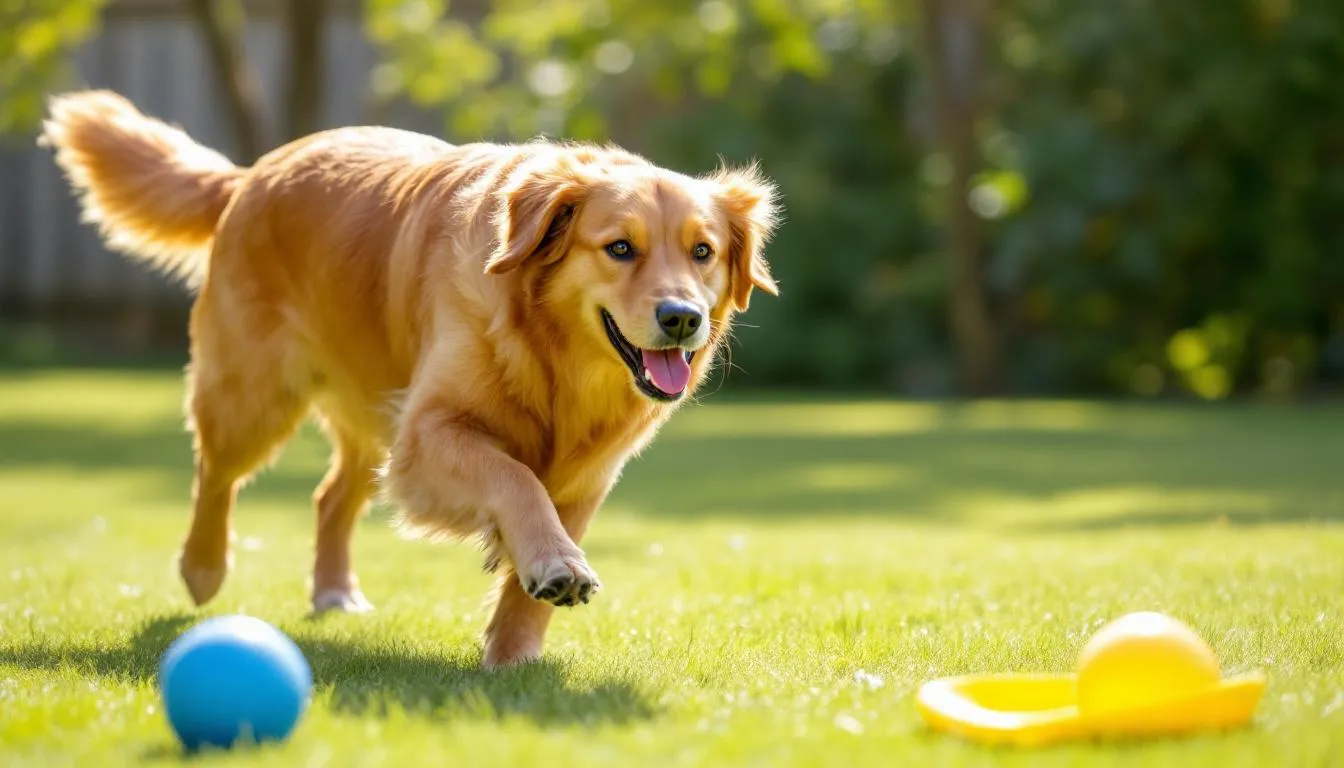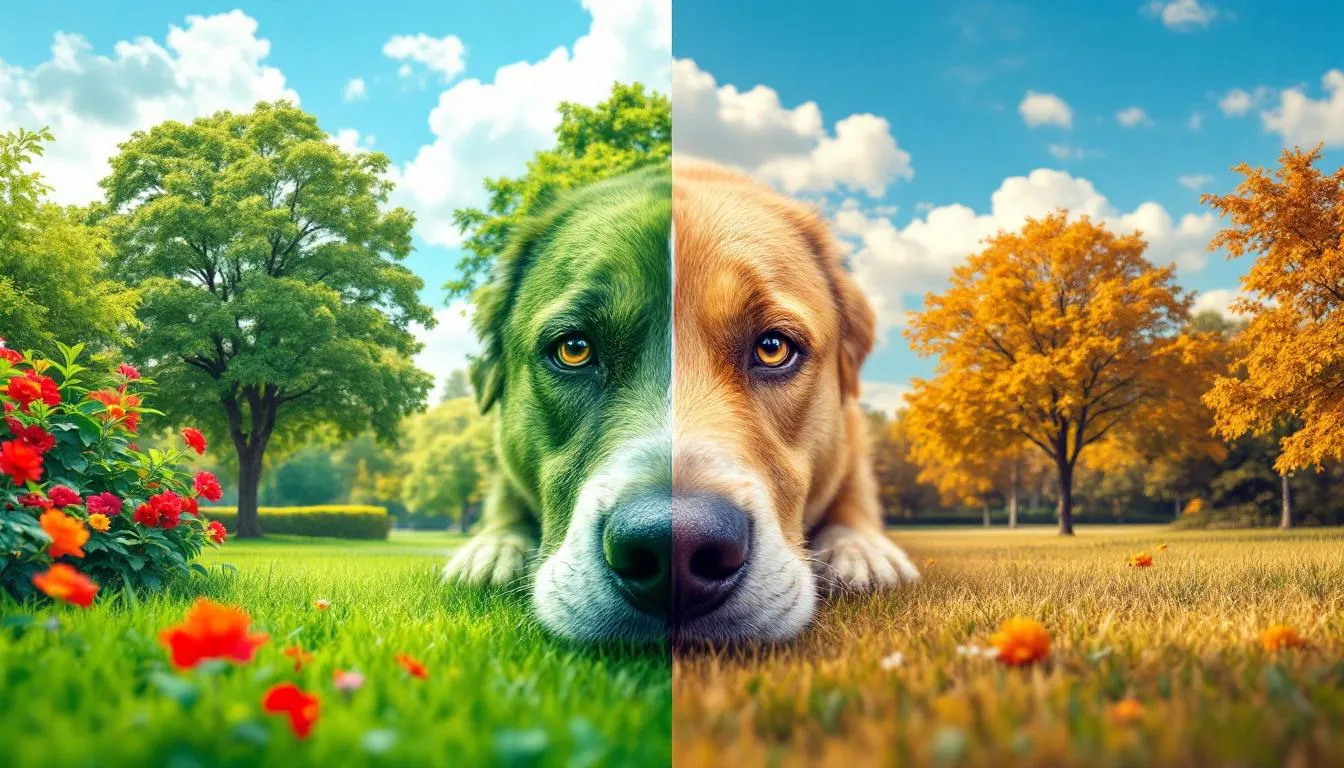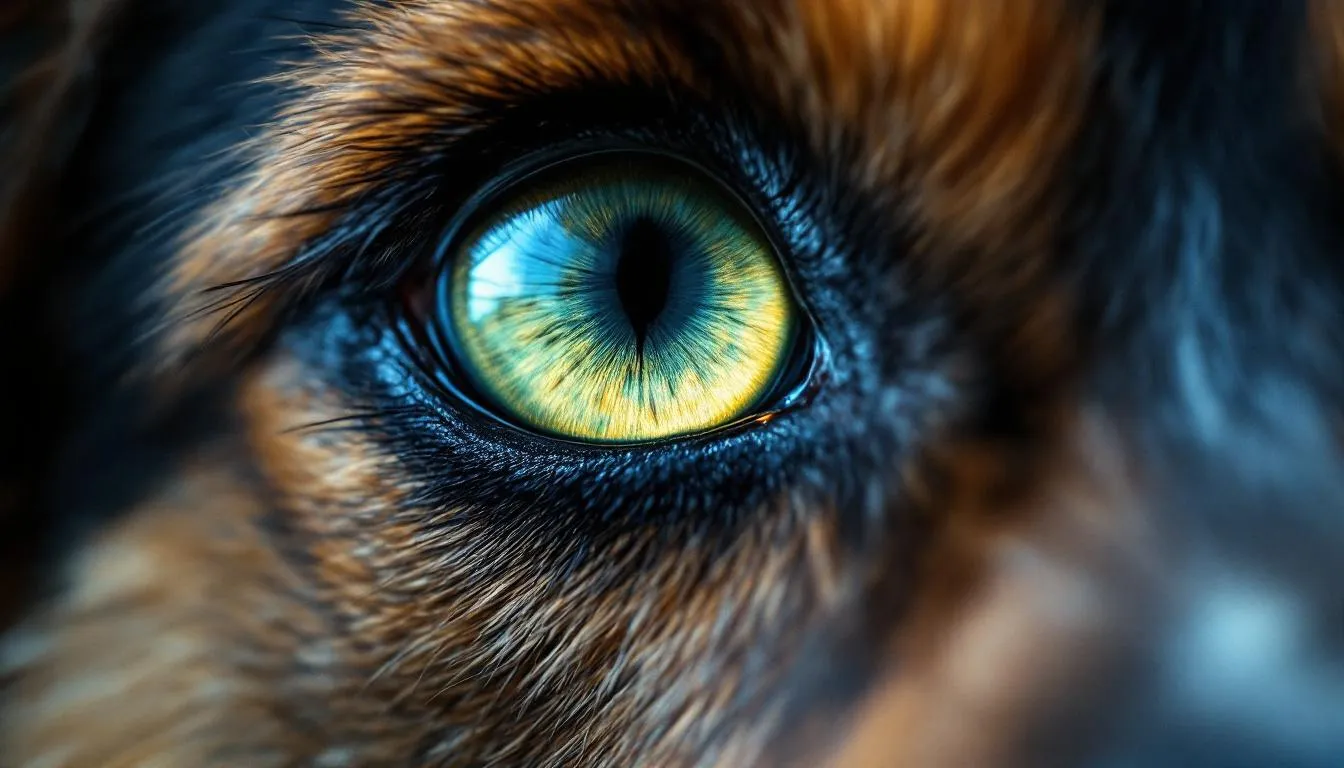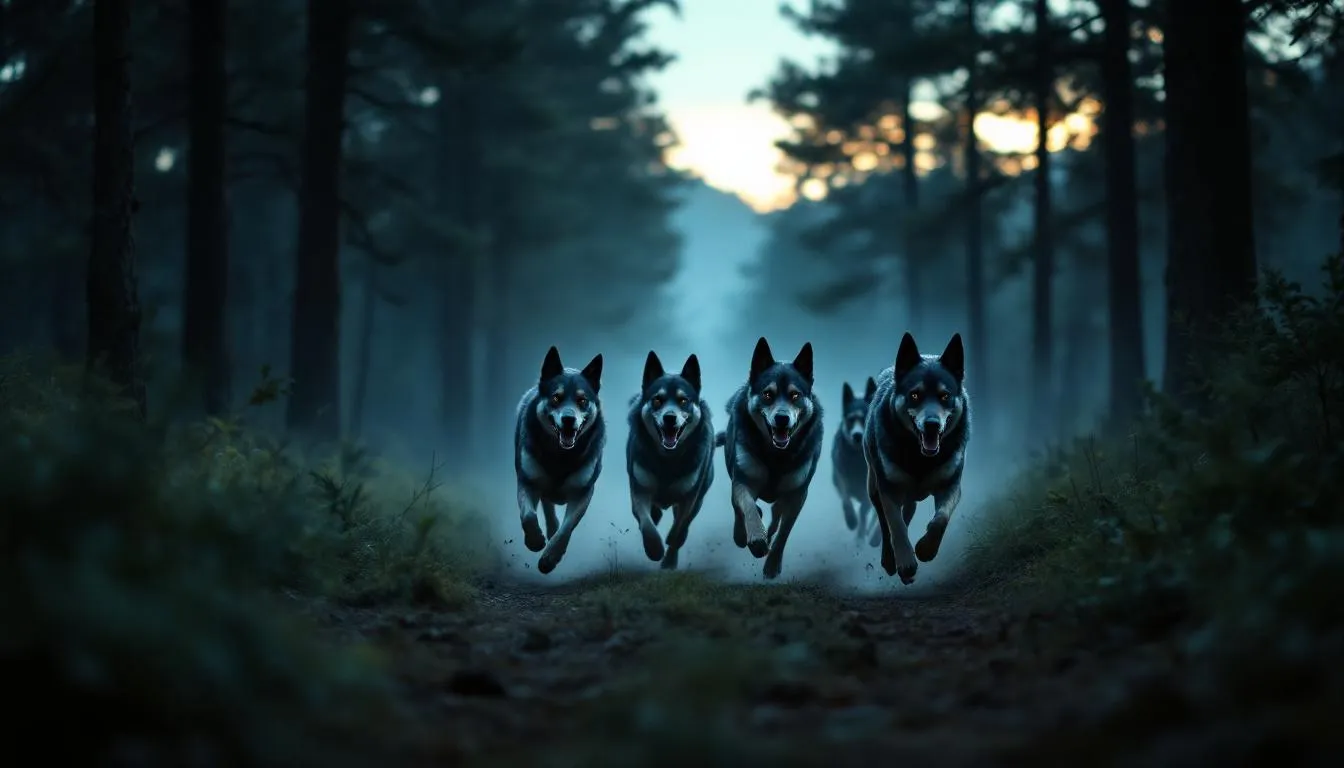

Key Takeaways
Dogs are not completely colorblind - they see colors in a blue and yellow spectrum similar to humans with red-green color blindness
- Dogs are not completely colorblind - they see colors in a blue and yellow spectrum similar to humans with red-green color blindness
- Dogs have dichromatic vision with only two types of color receptors (cones) compared to humans’ three types
- Red and green objects appear as brownish-gray or tan shades to dogs, making these colors difficult to distinguish
- Blue and yellow toys are most visible to dogs, while red toys on green grass essentially disappear from their view
- Dogs compensate for limited color vision with superior night vision, motion detection, and an exceptionally strong sense of smell
Dogs have dichromatic vision with only two types of color receptors (cones) compared to humans’ three types
Red and green objects appear as brownish-gray or tan shades to dogs, making these colors difficult to distinguish
Blue and yellow toys are most visible to dogs, while red toys on green grass essentially disappear from their view
Dogs compensate for limited color vision with superior night vision, motion detection, and an exceptionally strong sense of smell
For decades, many people believed that dogs see the world in black and white, like an old television show. This persistent myth has finally been debunked by modern scientific research. The truth about what colors can dogs see is far more fascinating and has practical implications for every dog owner.
Dogs actually possess what scientists call dichromatic vision, meaning they can see colors, just not the same range that humans can perceive. Understanding your dog’s vision can help you choose better toys, improve training effectiveness, and gain deeper insight into how your furry friends experience the world around them.
The Science Behind Dog Color Vision
The foundation of color vision lies in specialized cells called cones located in the retina. While humans have three types of cones that detect red, green, and blue wavelengths of light (called trichromatic vision), dogs possess only two types of color sensing receptors. This biological difference is what creates dichromatic vision in most dogs.
Research conducted by Neitz, Geist, and Jacobs in 1989 first definitively proved that dogs can see colors, overturning decades of assumptions. Their studies revealed that dogs’ two cone types are maximally sensitive to wavelengths corresponding to blue-violet (approximately 429 nanometers) and yellow (around 555 nanometers).
This dichromatic system works similarly to red green color blindness in humans, which affects about 8% of men and 0.5% of women. When yellow light stimulates the appropriate cone receptors in a dog’s eyes, neural circuits become excited. Blue light triggers different neural responses, creating the sensation of blue and yellow colors. However, both red and green wavelengths produce essentially neutral outputs, resulting in grayscale perception for those segments of the color spectrum.
The absence of cone receptors sensitive to longer red wavelengths eliminates dogs’ capacity to distinguish between reds, oranges, and certain greens. These colors appear to them as various shades of brown, gray, or tan instead of the vibrant hues that human eyes perceive.
What Colors Dogs Can Actually See
Understanding the colors that dogs can actually perceive helps explain their behavior and preferences. The canine color spectrum is dominated by blues and yellows, for a dog colorblind goes along with combinations of these primary colors.
Blue Spectrum : Dogs see blues clearly and can distinguish between different blue shades. A blue toy stands out prominently against most backgrounds, making it an excellent choice for play and training. From deep navy to bright sky blue, these colors remain vivid and distinguishable to canine eyes.
Yellow Spectrum : Yellow hues appear vibrant and easily distinguishable to dogs. Whether it’s a bright yellow ball or pale yellow rope, these items catch a dog’s attention quickly. The yellow spectrum extends from pale cream colors to rich golden yellows, all of which remain clearly visible to dogs.
White and Gray : Neutral colors like white, gray, and black are easily perceived by dogs. These achromatic colors provide strong contrast and are readily detected against most backgrounds.
Blue-Yellow Combinations : The combination of blue and yellow creates the full range of colors that dogs can see. Greenish-blues might appear as blue, while yellowish-greens would look predominantly if the dogs color blind and yellow to canine vision.
Dogs’ dichromatic vision means they experience a world painted primarily in these blue and yellow tones, with everything else appearing as various shades of brown, gray, or tan.


Colors That Are Invisible or Confusing to Dogs
The limitation of having only two types of cones means that certain colors essentially disappear from a dog’s visual world or become confusingly similar to other objects.
Red Objects : What appears as a bright red ball to human eyes looks dark brown, gray, or even black to dogs. This explains why dogs sometimes seem to ignore red toys or have difficulty finding them during fetch games as the dog color blindness attributes.
Green Grass and Foliage : The lush green grass that humans see appears tan or brownish to canine eyes. This creates significant challenges when red or orange objects are placed on green grass - they essentially become camouflaged.
Orange Items : Orange objects blend with reds in a dog’s vision, appearing as muted brown shades rather than the vibrant color humans perceive. An orange frisbee on green grass becomes particularly difficult for dogs to spot.
Purple Objects : Purple appears blue to dogs since they cannot see the red component that humans use to distinguish purple from blue. This means purple toys may be visible, but dogs perceive them as blue items even if they might not be one of their dog toys.
The classic example that illustrates this limitation is a red ball thrown onto green grass. While humans easily spot the bright red against the green background, dogs see a brownish object against a brownish background - making it nearly invisible. This is why many dogs seem to rely more on their sense of smell and hearing to locate toys rather than their sight alone.
Historical Myths About Dog Vision
The misconception that dogs see only in black and white has deep historical roots. In 1937, Will Judy, a writer and dog trainer, published the claim that dogs were completely colorblind and could only perceive the world in shades of gray. This assertion became widely accepted despite lacking scientific evidence.
During the 1960s, research seemed to support the idea that only primates possessed color vision, reinforcing the belief that other mammals, including dogs, were limited to black and white perception. These early studies relied on limited behavioral testing methods and made assumptions based primarily on anatomical observations of cone cell types.
These misconceptions persisted for decades, becoming entrenched in popular culture and even some veterinary literature. Many dog training guides and pet care books continued to perpetuate the black-and-white myth well into the 1980s.
Modern studies beginning in the 1980s started to challenge these long-held beliefs. Researchers developed more sophisticated testing methods, including modified versions of human color blindness tests adapted for dogs. The breakthrough 1989 study by Neitz and colleagues definitively proved that dogs could distinguish between certain colors, particularly in the blue and yellow ranges.
A particularly significant 2013 study demonstrated that under bright daylight conditions, dogs actually prefer to use color cues over brightness when making choices. This research showed that dogs would spontaneously choose objects based on color similarity even when brightness cues were intentionally reversed, proving that color perception plays an active role in canine behavior.


How Dog Vision Compares to Human Vision
While dogs may see fewer colors than humans, they excel in several other aspects of vision that give them distinct advantages in certain situations.
Visual Acuity : Dogs have significantly lower visual acuity compared to humans. While humans with normal vision can see clearly at 75 feet, dogs need to be approximately 20 feet away to see the same level of detail. This means most dogs are somewhat near sighted compared to human standards.
Field of Vision : Dogs possess superior peripheral vision with a field of view spanning approximately 240 degrees, compared to humans’ 180-degree range. This broader range helps dogs detect movement and potential threats from the sides without turning their heads.
Motion Detection : Dogs excel at detecting motion due to having more rods in their retinas. These rod cells are specialized for detecting movement and function well in low light conditions. Dogs can spot small movements that might escape human notice, making them excellent at tracking moving objects.
Night Vision : Dogs possess superior low light vision thanks to several adaptations. They have more rods than humans, and their eyes contain a reflective membrane called the tapetum lucidum. This reflective layer behind the retina bounces light back through the eye, giving dogs better dim light vision and causing their eyes to glow in photographs.
Color Processing : While humans process three primary colors through trichromatic vision, dogs work with their dichromatic system more efficiently for their needs. Human vision encompasses roughly 400-700 nanometers of light wavelength, with fine discrimination throughout. Dogs’ color discrimination focuses on two main peaks but processes this information quickly and effectively.
Practical Applications for Dog Owners
Understanding your dog’s vision has immediate practical applications that can improve training, play, and overall quality of life for your pet.
Toy Selection : Choose blue and yellow toys for maximum visibility during play sessions. A blue toy or yellow ball will stand out clearly against most backgrounds, making fetch games more engaging and successful. Avoid red and orange toys, especially when playing on green grass, as these become nearly invisible to your dog.
Training Equipment : Use visible colors for agility equipment and training markers. Blue and yellow cones, jumps, and markers will be much more noticeable to dogs than red or green alternatives. This improved visibility can enhance training effectiveness and reduce confusion.
Nighttime Safety : Since dogs have superior night vision, they can navigate in much dimmer conditions than humans. However, for nighttime walks or outdoor activities, consider glow-in-the-dark or reflective accessories in blue or yellow colors to maximize visibility for both you and your dog.
Indoor Environment : When setting up play areas or dog spaces, consider how color choices affect your pet’s ability to distinguish objects. Blue and yellow items will be most noticeable, while red and green objects may blend together or with surroundings.
Understanding Behavior : If your dog seems to ignore certain toys or has difficulty finding specific objects, consider whether the color might be the issue. A dog that appears uninterested in a red toy might simply be unable to see it clearly against the background.
Food and Water Bowls : While dogs rely heavily on their sense of smell for food, choosing blue or yellow bowls can provide better visual contrast, especially for older dogs with declining vision.


Evolutionary Advantages of Dog Vision
The dichromatic vision system in dogs isn’t a limitation - it’s an evolutionary adaptation that provided significant advantages for their ancestors and continues to benefit modern dogs.
Crepuscular Adaptation : Dogs evolved as crepuscular hunters, most active during dawn and dusk when light levels are low and color vision is less critical. During these times, the ability to detect motion and see in low light conditions was far more valuable than distinguishing between red and green colors.
Enhanced Motion Detection : By having fewer cone types dedicated to color, dogs can allocate more neural resources to detecting motion. This specialization made their ancestors more effective at tracking prey and avoiding predators. Modern dogs retain this ability, making them excellent at sports like agility and flyball.
Superior Night Vision : The same adaptations that limit color vision enhance dogs’ ability to see in dim light conditions. More rods, larger pupils, and the reflective tapetum lucidum all contribute to night vision that far exceeds human capabilities. This made nocturnal hunters more successful and helps modern dogs navigate in conditions where humans would be nearly blind.
Sensory Compensation : Reduced color vision allowed evolutionary pressure to enhance other senses dramatically. Dogs’ sense of smell is 1,000 to 10,000 times stronger than humans’, providing detailed information about their environment that goes far beyond what color vision could offer. This sensory trade-off proved highly advantageous for survival.
Energy Efficiency : Processing fewer colors requires less neural energy, allowing the brain to dedicate more resources to other critical functions like scent processing, hearing, and motor coordination. This efficient allocation of neural resources contributed to dogs’ success as hunting companions and working animals.
The dichromatic vision system represents a perfectly adapted sensory package for the canine lifestyle, emphasizing the abilities most crucial for their evolutionary success while maintaining adequate color perception for modern life as companion animals.
FAQ
Can dogs see in complete darkness?
No, dogs cannot see in complete darkness any better than humans can. However, they can see clearly in much dimmer light conditions thanks to their tapetum lucidum (reflective layer) and higher concentration of rod cells. Dogs require only about one-sixth the amount of light that humans need to see clearly.
Do different dog breeds see colors differently?
All dogs have the same dichromatic color vision regardless of breed - they all see the same blue and yellow spectrum. However, visual acuity does vary by breed, with sight hounds like Greyhounds and Whippets typically having better overall vision and depth perception than flat-faced breeds.
Why don’t dogs seem to care about toy colors if they can see some colors?
Dogs rely much more heavily on scent, texture, sound, and movement when selecting toys and interacting with objects. While they can see blue and yellow clearly, their sense of smell provides exponentially more information about their environment than their vision does.
Can dogs be trained to distinguish between red and green objects they can’t see well?
Yes, dogs can learn to differentiate between red and green objects using brightness, saturation, and texture cues rather than actual color perception. They may learn that one object is darker or lighter than another, even though both appear brownish to them.
Are there any colors besides blue and yellow that dogs can see clearly?
Dogs see all colors as combinations or variations of blue, yellow, white, and gray. They cannot perceive any true red, green, orange, or purple hues. However, they can distinguish between different intensities and saturations within their visible spectrum, creating a more nuanced visual experience than simple blue and yellow.
FAQ
Can dogs see in complete darkness?
No, dogs cannot see in complete darkness any better than humans can. However, they can see clearly in much dimmer light conditions thanks to their tapetum lucidum (reflective layer) and higher concentration of rod cells. Dogs require only about one-sixth the amount of light that humans need to see clearly.
Do different dog breeds see colors differently?
All dogs have the same dichromatic color vision regardless of breed - they all see the same blue and yellow spectrum. However, visual acuity does vary by breed, with sight hounds like Greyhounds and Whippets typically having better overall vision and depth perception than flat-faced breeds.
Why don’t dogs seem to care about toy colors if they can see some colors?
Dogs rely much more heavily on scent, texture, sound, and movement when selecting toys and interacting with objects. While they can see blue and yellow clearly, their sense of smell provides exponentially more information about their environment than their vision does.
Can dogs be trained to distinguish between red and green objects they can’t see well?
Yes, dogs can learn to differentiate between red and green objects using brightness, saturation, and texture cues rather than actual color perception. They may learn that one object is darker or lighter than another, even though both appear brownish to them.
Are there any colors besides blue and yellow that dogs can see clearly?
Dogs see all colors as combinations or variations of blue, yellow, white, and gray. They cannot perceive any true red, green, orange, or purple hues. However, they can distinguish between different intensities and saturations within their visible spectrum, creating a more nuanced visual experience than simple blue and yellow.






